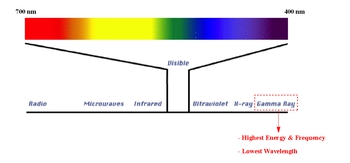Gamma radiation is a form of electromagnetic radiation that occupies a significant position within the electromagnetic spectrum. It is characterized by having the highest energy, which correlates with the shortest wavelength and the highest frequency. Understanding the relationships between energy, frequency, and wavelength is crucial in this context.
In the electromagnetic spectrum, energy and frequency are directly proportional. This means that as the energy of a wave increases, its frequency also increases. Conversely, wavelength is inversely proportional to both energy and frequency. Therefore, when energy and frequency are high, the wavelength is low, and vice versa. Wavelength is defined as the distance between successive crests of a wave, while frequency refers to the number of waves that pass a given point in one second.
For gamma rays, their high energy results in a very short wavelength, which allows for a high frequency. This relationship can be summarized by the equation:
Energy (E) = h × f
where h is Planck's constant and f is the frequency of the wave. Gamma rays are noted for having the highest energy levels in the electromagnetic spectrum, surpassed only by cosmic rays, which are not typically covered in basic chemistry discussions. For foundational studies, it is essential to recognize that gamma rays represent the peak of energy, frequency, and the corresponding minimal wavelength within the electromagnetic spectrum.





